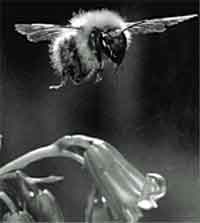To bee or not to bee
 new horticultural trends in the uk have spelled bad times for bumble-bees, large insects belonging to the Bombus family. The bumble-bee population is declining; among Britain's 19 species of bumble-bees, only six boast a healthy population. Modern gardening practices with hybridised varieties of flowers have driven the bumble-bee to the edge.
new horticultural trends in the uk have spelled bad times for bumble-bees, large insects belonging to the Bombus family. The bumble-bee population is declining; among Britain's 19 species of bumble-bees, only six boast a healthy population. Modern gardening practices with hybridised varieties of flowers have driven the bumble-bee to the edge.
The hybridised flowers look larger and have greater commercial use. But their nectar yield is little. This has meant loss of sustenance for the bumble-bees, who need large amounts of energy to fly as they are bulkier than honey bees. They store very little honey in the bee-colony and die in a matter of days without a steady supply of nectar ( New Scientist , Vol 154, No 2087).
Bumble-bees are not seen as the most valuable of the species. But contrary to popular belief, they are of immense economic importance. They are very efficient and irreplaceable pollinators with long tongues
Related Content
- First food: business of taste
- Order of the National Green Tribunal regarding the deplorable condition of a water tank, Golconda Fort, Hyderabad, Telangana, 05/06/2025
- Order of the National Green Tribunal in the matter of Futala lake pollution, Nagpur, Maharashtra, 05/06/2025
- Order of the National Green Tribunal regarding large scale felling of toddy yielding palm trees in Bihar, 05/06/2025
- Order of the National Green Tribunal regarding deterioration of Nayar river, Uttarakhand, 05/06/2025
- Order of the National Green Tribunal regarding an illegal cracker unit in Thanjavur district, Tamil Nadu, 29/05/2025
